The Qualcomm Snapdragon 820 Performance Preview: Meet Kryo
by Ryan Smith & Andrei Frumusanu on December 10, 2015 11:00 AM EST- Posted in
- SoCs
- Snapdragon
- Qualcomm
- Snapdragon 820
GPU Performance
Shifting gears, let’s take a look at GPU performance. As we mentioned earlier, Qualcomm isn’t disclosing much about this GPU other than that it packs quite a bit more computational power than its predecessor and should be quite a bit faster in the process. This points to a potentially significant architectural shift, but that determination will have to wait for another time.
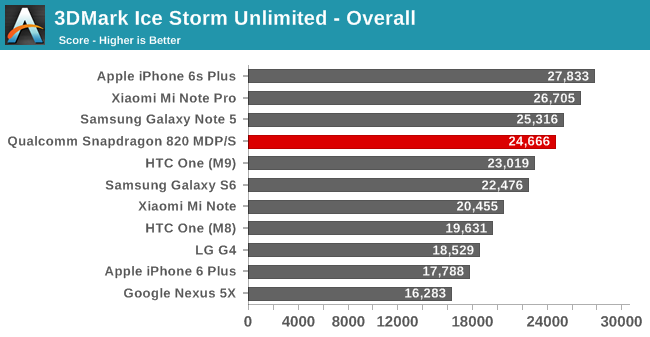
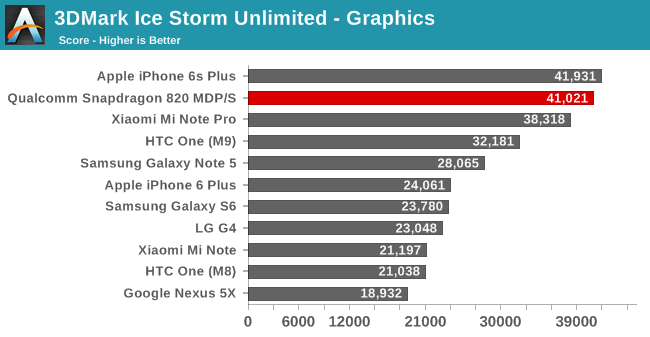
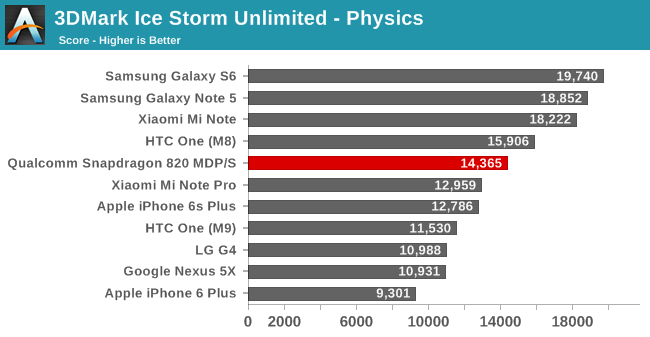
Starting with 3DMark Ice Storm Unlimited, the performance honestly doesn’t start out great. The overall score is significantly influenced by the physics score, which in turn is more concerned with the number of cores and their throughput on simple code than the ability to extract complex IPC. As a result the 4 CPU core 820 simply can’t catch up with the likes of the Samsung devices and their high-clocked big.LITTLE configurations. On the other hand the graphics score makes this the fastest Android phone to date, though relative to the 810 Mi Note Pro, perhaps not by a ton. Ultimately as this is an OpenGL ES 2.x test it’s not the most strenuous of tests these days, and comments from Qualcomm indicate that it may be a CPU-limited test on 820.
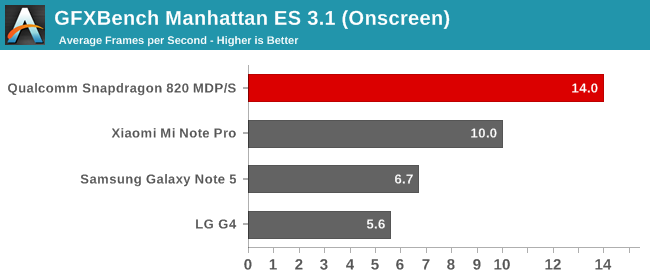
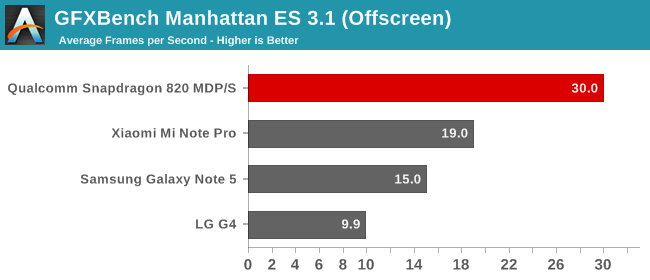
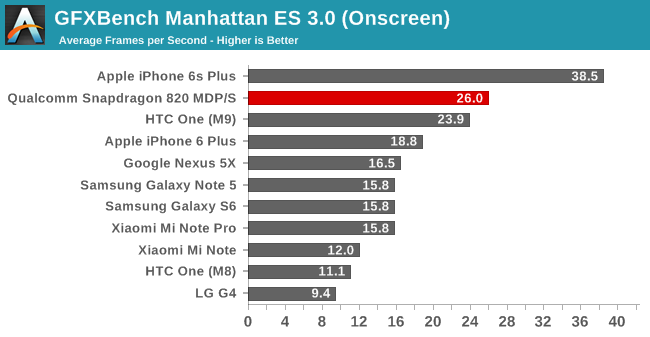
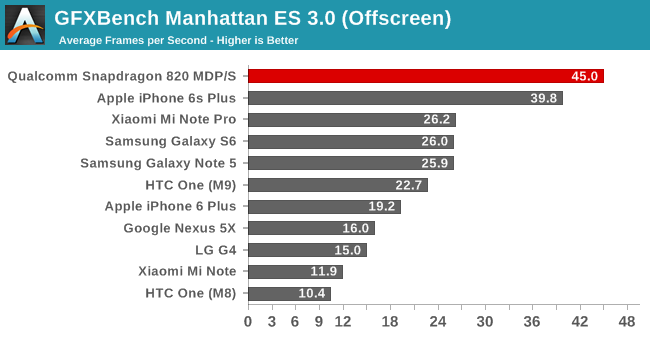
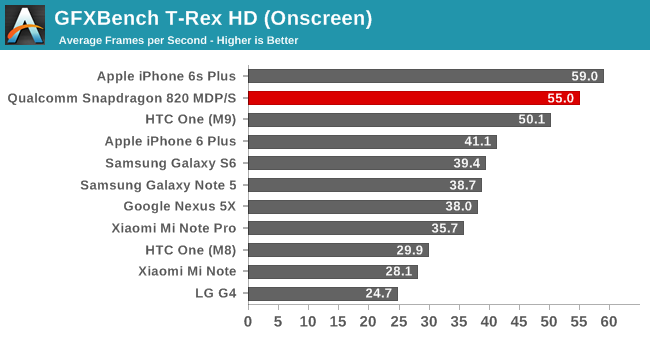
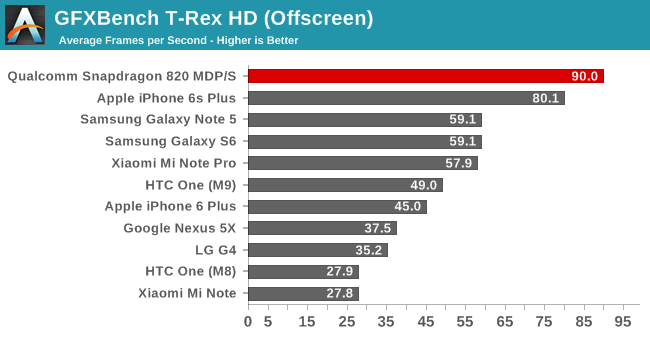
GFXBench on the other hand shows some massive gains for the 820 relative to any other Android device. In offscreen rendering mode, all 3 game tests – Manhattan ES 3.1, Manhattan ES 3.0, and T-Rex HD – put the 820 MDP/S as being 52% (or more) faster than the next-fastest Android device, either the 810 based Mi Note Pro or the Exynos 7420 based Samsung Galaxy Note 5. The single biggest jump we see is with Manhattan ES 3.0 at 72%, while the ES 3.1 version dials that back down to 52%. Even the iPhone 6s Plus, well known for its powerful GPU, is handily and consistently surpassed by the 820 here. Only due to the 6s Plus’s lower rendering resolution of 2208x1242 does it surpass the MDP/S in onscreen tests, as the latter needs to render at 2560x1600 (~50% more pixels). Qualcomm was aiming for some big GPU performance gains here and so far they are delivering.

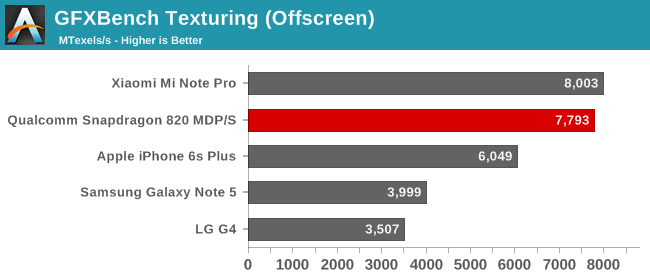
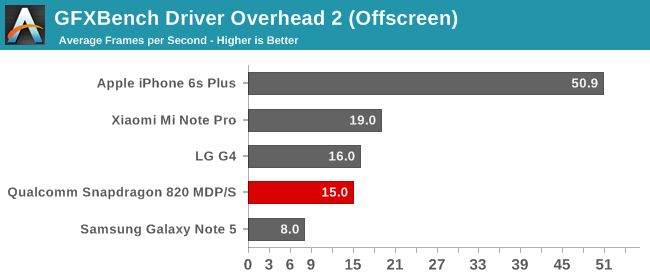
Curiously, GFXBench’s synthetic feature tests don’t show the same gains. Offscreen ALU performance is only slightly improved over the 810 (10%) or in the case of texturing is an outright regression. None-the-less full gaming performance is clearly in the 820’s favor. I’ve long suspected that the Adreno 430 GPU in the 810 had some kind of architectural bottleneck – perhaps an ALU/texture array that was difficult to fully utilize – and what we’re seeing here would back up that claim, as if that was the case then correcting it would have allowed Qualcomm to significantly boost their rendering performance while only barely changing their synthetic performance. Otherwise I find it a bit surprising that the driver overhead score is a bit worse on 820 than 810, which may be a result of the immature GPU drivers on this early device.










146 Comments
View All Comments
jjj - Thursday, December 10, 2015 - link
I will remind you that here you got about the equivalent of 3 cores. So with 2 cores you would need 20% extra perf inside a 50% increase in per core power. So i was factoring in a certain amount of increase in power. If 20% increase in clocks with 50% increase in power is doable remains to be seen, we don't have enough data.That statement was about the core not about the device or the SoC and the core metrics are power,perf and area . The convos about the SoC and the device are different topics.
lucam - Friday, December 11, 2015 - link
Problem of your dogma is that you are comparing a prototype tablet versus a phone.That's why you are already mistaken...
michael2k - Thursday, December 10, 2015 - link
You ignore the fact that Apple has been shipping Kyro class HW since 2014 and Kyro isn't going to ship until 2016. A two year lead is commanding by any kind of definition.You talk as if only Qualcomm has access to 20% higher without also acknowledging that Apple already ships a very similar design, the A9X, that clocks 30% higher and has no L3 that is approximately 70% faster than the Kyro if we assume the Kyro performs similarly to the A8 at 1.4GHz.
jjj - Thursday, December 10, 2015 - link
You don't male any sense at all. Apple's old gen core wasn't all that fast while the ipad Pro had higher clocks because the form factor allows it. We are talking in a phone form factor.it is true that Apple's per core power consumption is a bit of an unknown so certain things are assumed.
Ryan is a fanboy and he tries to argue that fewer cores are better even he knows very well that more cores provide more computing power in the same TDP. AT worked hard to convince everybody that more core are better when Intel did it and now they are working hard to convince everybody that fewer cores are better when Apple does it because their OS is stuck in the past.
Pissedoffyouth - Thursday, December 10, 2015 - link
>Apple's old gen core wasn't all that fast while the ipad Pro had higher clocks because the form factor allows it. We are talking in a phone form factor.The 6s???????????????????????? That's a phone
>that more cores provide more computing power in the same TDP.
Oh yeah checking my facebook requires GPU like parallelism
lucam - Friday, December 11, 2015 - link
He will understand that next year at the time of 825 and A10....michael2k - Thursday, December 10, 2015 - link
http://www.anandtech.com/show/8554/the-iphone-6-re...The only part faster was the Tegra K1 in a tablet form factor.
Honor 6 and Galaxy S6 were close but still overall slower.
testbug00 - Monday, December 14, 2015 - link
you have a few problems. And, the 6s runs very cool compared to every phone with a high end Qualcomm I have had. Which includes S4, SD800x2, SD810.I'm quite confident the iPhone 6s could clock the CPU higher at the expensive of not being able to keep it at max clockspeed in the smaller variant of the phone.
techconc - Wednesday, December 16, 2015 - link
jjj, your comments on this topic are off-base. For starters, there is nothing stuck in the past about iOS. It handles symmetric multiprocessing as well as any device. Realistically, there are far more work roads that are optimized for one processor. Every task will feel faster when a device with fewer but faster cores. There are very few workloads that truly benefit from multiple processors.extide - Thursday, December 10, 2015 - link
It's not using the GPU or DSP. That doesnt just happen automagically ... the app needs to be specifically coded to do that. The reason it gets a high photo editing score is because if has really really great FP performance. Note the Geekbench FP scores -- it is able to beat the 810 in MT in all but ONE test with half as many cores and those 2 cores running much slower.